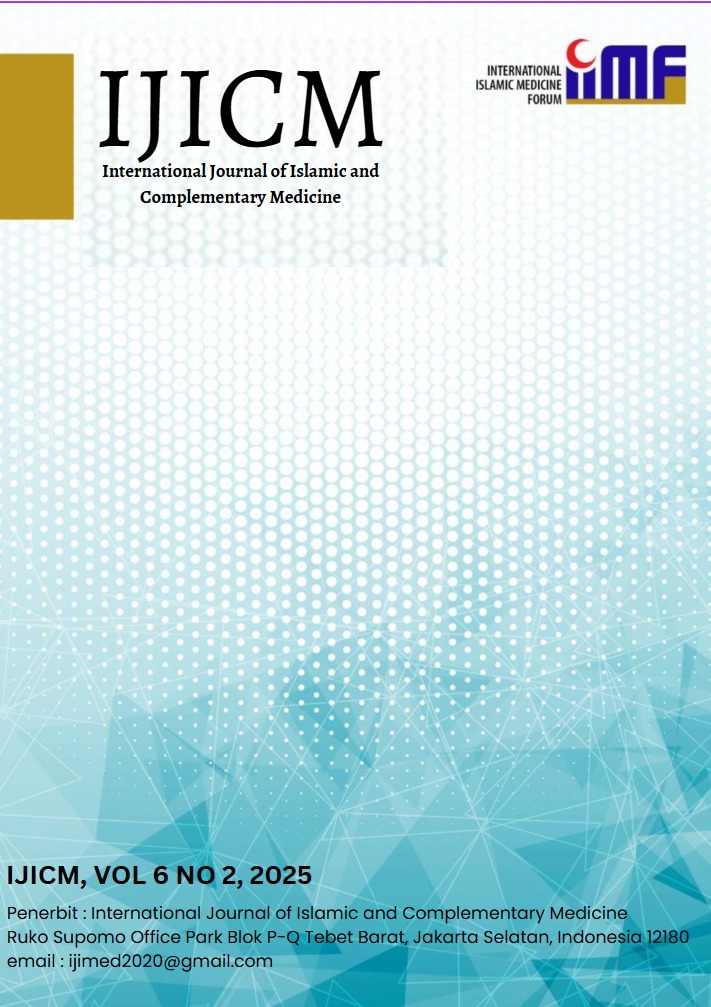A CASE STUDY ON WEIGHT LOSS INVOLVING A WOMAN UTILISING WET CUPPING THERAPY, QURAN MEMORISATION AND PHYSICAL EXERSICE
##plugins.themes.academic_pro.article.main##
Abstract
This study seeks to elucidate the weight loss process using cupping, walking, and Quranic memorization. Characterized a process that transpires over an extended duration. This research employs a single subject research design (SSRD) utilizing a baseline and treatment framework (ABAB), with treatment administered according to the status of the obese patient. The study's results indicated a reduction in body weight throughout the three weight loss phases. The ABAB design was implemented for the cupping procedure, walking, and Quran memorization, as all were tailored to the situation of the obese patient. The conclusion is that thorough measures are essential, beginning with body weight, blood pressure, step count, and the quantity of Quranic verses remembered.
ABSTRAK
Penelitian ini bertujuan menggambarkan proses penurunan berat badan dengan bekam, jalan kaki dan menghafal Al-Quran. Digambarkan proses yang tidak terjadi dalam waktu singkat. Metode penelitian ini menggunakan single subject research design (SSRD) dengan desain baseline dan treatment (ABAB), treatment dilakukan berdasarkan kondisi penderita obesitas. Hasil penelitian yang diperoleh bahwa terjadi penurunan berat badan selama menjalankan 3 proses penurunan berat badan. ABAB desain dilakukan pada metode bekam, jalan kaki dan menghafal Al-Quran, karena semuanya dilakukan disesuaikan dengan kondisi penderita obesitas. Kesimpulan yang dapat diambil adalah dibutuhkan pengukuran yang komprehensif, mulai dari pengukuran berat badan, tekanan darah, jumlah langkah jalan kaki, dan jumlah ayat Al-Quran yang dihafal.
##plugins.themes.academic_pro.article.details##

This work is licensed under a Creative Commons Attribution-ShareAlike 4.0 International License.
References
- Cobb LK, Appel LJ, Franco M, Jones-Smith JC, Nur A, Anderson CAM. The relationship of the local food environment with obesity: A systematic review of methods, study quality, and results. Vol. 23, Obesity. Blackwell Publishing Inc.; 2015. p. 1331–44.
- Smith KB, Smith MS. Obesity Statistics. Prim Care - Clin Off Pract. 2016 Mar 1;43(1):121–35.
- Owens E, Nawar R, Bhatti R, Tangi F, Isailovic T, Artime E, et al. Impact of Obesity on Individuals in the United Arab Emirates: A Real-World Patient and Physician Survey. Endocr Pract. 2023 Dec;29(12):S166.
- Rachmi CN, Li M, Alison Baur L. Overweight and obesity in Indonesia: prevalence and risk factors—a literature review. Vol. 147, Public Health. Elsevier B.V.; 2017. p. 20–9.
- Ayuningtyas D, Kusuma D, Amir V, Tjandrarini DH, Andarwati P. Disparities in Obesity Rates among Adults: Analysis of 514 Districts in Indonesia. Nutrients [Internet]. 2022 Aug 1 [cited 2024 May 20];14(16). Available from: https://pubmed.ncbi.nlm.nih.gov/36014838/
- Chooi YC, Ding C, Magkos F. The epidemiology of obesity. Metabolism. 2019 Mar 1;92:6–10.
- Fabricatore AN, Wadden TA. Psychological aspects of obesity. Clin Dermatol. 2004;22(4 SPEC. ISS.):332–7.
- Tauqeer Z, Gomez G, Stanford FC. Obesity in Women: Insights for the Clinician. J Women’s Heal. 2018 Apr 1;27(4):444–57.
- Broughton DE, Moley KH. Obesity and female infertility: potential mediators of obesity’s impact. Fertil Steril. 2017 Apr 1;107(4):840–7.
- Patel S. Polycystic ovary syndrome (PCOS), an inflammatory, systemic, lifestyle endocrinopathy. Vol. 182, Journal of Steroid Biochemistry and Molecular Biology. Elsevier Ltd; 2018. p. 27–36.
- Ajmal N, Khan SZ, Shaikh R. Polycystic ovary syndrome (PCOS) and genetic predisposition: A review article. Vol. 3, European Journal of Obstetrics and Gynecology and Reproductive Biology: X. Elsevier Ireland Ltd; 2019.
- Itriyeva K. The effects of obesity on the menstrual cycle. Curr Probl Pediatr Adolesc Health Care [Internet]. 2022 Aug 1 [cited 2024 Jun 14];52(8). Available from: https://pubmed.ncbi.nlm.nih.gov/35871162/
- Dietrich P, Hellerbrand C. Non-alcoholic fatty liver disease, obesity and the metabolic syndrome. Vol. 28, Best Practice and Research: Clinical Gastroenterology. Bailliere Tindall Ltd; 2014. p. 637–53.
- Darmawan A, Setyningrum N, Saputri A. The Quran and Psychological Stress in The Elderly during The Covid-19 Pandemic. Int J Islam Complement Med. 2022 Sep 23;3(2):65–72.
- Hibban MF. Living Quran and Sunnah as the Foundation of A Holistic Healthy Lifestyle. Int J Islam Complement Med. 2022 Sep 23;3(2):49–56.
- Logan RL, Hickman RR, Harris RS, Heriza BC. Develop Med Child Neuro - 2008 - Logan - Single‐subject research design recommenda.pdf. Dev Med Child Neurol. 2008;99–103.
- Gliner JA, Morgan GA, Harmon RJ. Single-subject designs. J Am Acad Child Adolesc Psychiatry [Internet]. 2000;39(10):1327–9. Available from: http://dx.doi.org/10.1097/00004583-200010000-00023
- Zuidersma M, Riese H, Snippe E, Booij SH, Wichers M, Bos EH. Single-Subject Research in Psychiatry: Facts and Fictions. Front Psychiatry. 2020;11(November).
- Ath-Thabari JI. NU Online. 2024 [cited 2024 Sep 30]. Tafsir Quran Tahlili. Available from: https://quran.nu.or.id/yunus/57
- Renáta Cserjési. Emotions, cognition, awareness and behavior in eating disorders. Comparison between obesity and anorexia nervosa. Orv Hetil. 2009;150(24).
- De Lorenzo A, Gratteri S, Gualtieri P, Cammarano A, Bertucci P, Di Renzo L. Why primary obesity is a disease? J Transl Med [Internet]. 2019;17(1):1–13. Available from: https://doi.org/10.1186/s12967-019-1919-y
- Nussbaumerova B, Rosolova H. Obesity and Dyslipidemia. Curr Atheroscler Rep. 2023;25(12):947–55.
- Vekic J, Zeljkovic A, Stefanovic A, Jelic-Ivanovic Z, Spasojevic-Kalimanovska V. Obesity and dyslipidemia. Metabolism [Internet]. 2019;92:71–81. Available from: https://doi.org/10.1016/j.metabol.2018.11.005
- Roy PK, Islam J, Lalhlenmawia H. Prospects of potential adipokines as therapeutic agents in obesity-linked atherogenic dyslipidemia and insulin resistance. Egypt Hear J [Internet]. 2023;75(1). Available from: https://doi.org/10.1186/s43044-023-00352-7
- Clemente-Suárez VJ, Redondo-Flórez L, Beltrán-Velasco AI, Martín-Rodríguez A, Martínez-Guardado I, Navarro-Jiménez E, et al. The Role of Adipokines in Health and Disease. Biomedicines. 2023;11(5).
- Kang D, Shin WC, Kim T, Kim S, Kim H, Cho JH, et al. Systematic review and meta-analysis of the anti-obesity effect of cupping therapy. Med. 2023;102(24).
- Kim H, Kim KW, Chung WS. Effects of cupping therapy for obesity: A protocol for systematic review and meta-analysis. Med. 2021;100(44).
- Merritt EK. Why is it so hard to lose fat? Because it has to get out through your nose! Anxercise physiology laboratory on oxygen consumption, metabolism, and weight loss. Adv Physiol Educ. 2021;45(3):599–606.
- Chiu YH, Tsai SC, Lin CS, Wang LY, Huang KC. Effects of a 12-week walking intervention on circulating lipid profiles and adipokines in normal weight and abdominal obese female college students. J Exerc Sci Fit. 2023;21(3):253–9.

